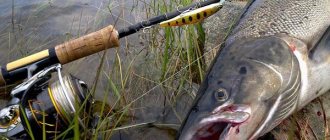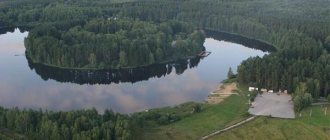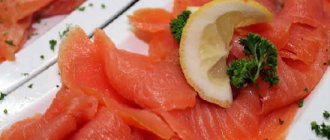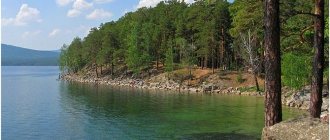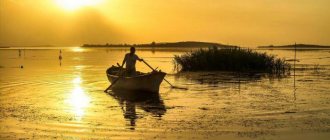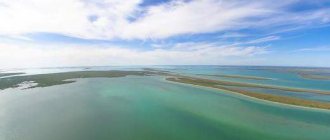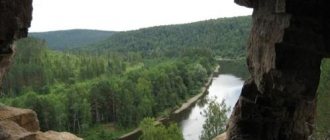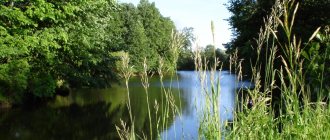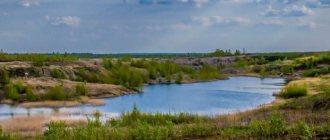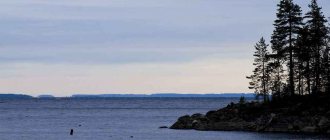There comes a time in the life of every fisherman when he wants to give up his usual fishing with a rod or spinning rod and try something new, previously unknown to him. And here it is difficult to imagine a more worthy opponent than Onega salmon. There are not so many ways of sport fishing for salmon on Lake Onega, spinning and trolling. The word trolling comes from the English word (trolling, fishing with a lure), and if we consider this word in a new context, trolling is a method of fishing from a moving craft. Previously, before this term came into our lexicon, this method of fishing was called “track” and “Katyusha”. “Path” differs from “Katyusha” in the following ways:
- Track - towing bait on a moving craft, where the lures follow strictly behind the vessel, thereby creating a so-called track.
- Katyusha - towing bait on a moving craft, using additional devices (glider, boat, sled) that move the bait away from the side of the vessel and tow them behind it. The number of towed baits with one “glider” can vary from one to six, it depends on the size of the vessel and the type of “glider”.
Trolling - who is it for?
Reading articles in magazines and posts on forums, many anglers have a negative impression of trolling. They often say that trolling is for the “obese” rich, that this type of fishing is for the lazy, that this is not fishing, but stupid fishing, etc. I do not agree with this opinion, because... I’ve been trolling in Lake Onega for a long time and it’s the same kind of fishing as spinning and fishing rod. The main trophy in trolling fishing on Lake Onega is Onega salmon. It is known that salmon is a fish that never stands still, it is always on the move and for this reason only, it can only be caught by trolling. But there are exceptions to any rule. There have been cases of catching salmon in Lake Onega right off the shore at a depth of 1-1.5 meters, as well as on ludas while fishing for perch with roach, but these are just isolated cases. The main goal of trolling fishing is to compete with a strong opponent, and for this you have to walk dozens of miles, change movement tactics, change bait, monitor gear, analyze the bottom topography and the presence of fish there.
Trolling on Lake Onega is the shortest path to successful fishing!
Lake Onega is one of the largest freshwater bodies of water in Europe. Onego is famous for its clear water, intricately rugged banks, and the unique beauty of dawns and sunsets. The bottom topography is very complex, especially in the northern parts of the reservoir; numerous pronounced increases and decreases in the bottom are characteristic. The relief forms are mostly elongated from northwest to southeast. Typical forms are luds (shallow rocky shoals), selgi (deep-sea bottom elevations with rocky and sandy soils in the southern part of the lake), underwater ridges and ridges, as well as depressions and pits. Such a relief creates favorable conditions for the life of the fish population of the lake, and at the same time for elite and sport fishing.
Trolling - this ancient method of catching a predator was formerly known as "track". The word “trolling” in English means a method of fishing when the bait is pulled behind a moving boat. The bait can be either artificial bait (spinners, wobblers, jigs, spinners, etc., etc.), or live bait or dead fish (rig).
It must be said that modern trolling is fundamentally different from the track, as it involves the use of an outboard motor. This is a very exciting and rewarding way of fishing, which brings wonderful trophy specimens and indescribable moments of fighting with large, strong and beautiful fish. The advantages of trolling are that a much larger part of the reservoir is fished in a shorter period of time, and you can use very large and heavy baits, which are necessary for catching large fish. When a concentration of fish is detected, you can simply drop anchor and move on to fishing using the spinning method.
The main components of trolling equipment are a motor and a boat, the choice of which largely determines comfort and, most importantly, safety on the water. Fishing on Lake Onega is always associated with weather surprises: the wind is a little more than 7 m/s, and the waves are already noticeably rocking the boat. Trolling is, first of all, covering significant distances, both to the immediate place of fishing and during the fishing process. In this case, the boat will need high speed and comfortable movement on the wave.
Today in Petrozavodsk there are several companies that organize fishing on Onega on modern trolling boats, which are equipped with a great variety of all kinds of fish-finding equipment and devices for spatial orientation. In addition to the usual echo sounder, you can find here a sonar, an electronic fish lure, and a water temperature meter at different depths.
Lake Onega is predominantly a salmon reservoir: a third of the fish inhabiting it belong to the salmon family. In recent years, effective work has been carried out on the artificial reproduction of salmon in Lake Onega. According to the Northern Fisheries Research Institute, the number of feeding salmon is about 450 tons. At the same time, 85 percent is salmon of hatchery origin. In 2005, a decision was made to remove freshwater salmon from the Red Book of the Russian Federation.
Salmon is a coveted catch. Its main habitat is the western coast of Lake Onega. As practice shows, salmon weighing from 3 to 6-8 kg are mainly caught. And the best time for salmon fishing is autumn and spring, when the water is cold and the weather is cloudy and there is a small wave on the lake. In addition to salmon, brown trout, trout, and palia are of great interest among red fish.
In total, 47 species and varieties of fish have been discovered in the lake to date. Some of them are quite rare, for example, sterlet or eel. The remaining 43 species of fish are ubiquitous and in sufficient quantities. However, for trophy fishing, the following species can be distinguished: palia, whitefish, kelets, grayling, pike, pike perch, perch, burbot.
From five to nine hours spent with an experienced instructor in an equipped boat, moving at low speed along the spacious Onega-Father with regular bites, with an exciting fight for the trophy, will remain in your memory for many years.
You can familiarize yourself with the tourist offers of our project on trolling in Karelia.
Highlights of salmon fishing in Lake Onega
Fishing in Karelia in summer for salmon in Onega is carried out at depths from 9 to 70 meters, depending on the selected area of the lake. Therefore, you have to constantly monitor the position of the boat and remember the depths at which the baits are buried, because Often in Onega the depths can change from 30 to 3 meters in a matter of minutes. And if necessary, you need to quickly change the course or depth of the baits. Agree, this is much more difficult than fishing in “stationary” mode.
When trolling, from one to sixteen spinning rods and the same number of baits are used. The main goal of trolling with a large number of baits is to imitate a school of small fish; also, a large number of spinners creates more powerful vibrations, which is what attracts a predator. Accordingly, the selection of current spinners is also important.
In each region of Onega, salmon prefer different types of spoons, and for this reason I will not indicate specific ones, because... in the south of Onega there are some priorities, and in the north there are others. The main types of spinners for salmon are Kuusamo Professor, Sebile, and Rapala wobblers, X-Rap Deep series, lengths of 8 and 10 cm. The main task is to choose the optimal bait, its color and present it correctly, this is where the skill lies.
Trolling fishing is extremely mobile. The large predator stays very locally and can change aggregation sites very quickly and over long distances, so you need to go out and check the most promising fishing spots. If you don’t observe any bites for a long time, and the echo sounder shows that there are small fish, then you need to radically change the fishing area and go 5-20 kilometers to another place.
Winter fishing on Lake Onega and in summer
Lake Onega for fishing is an ideal choice for going fishing in Karelia, or just relaxing on the shore. For our guests we have prepared houses on the shore of the lake, which is the second largest freshwater body of water in Europe.
There are many attractions scattered along the shore and islands of Onega, and winter fishing on Lake Onega, and summer fishing too, is so unpredictable that passionate fishermen from all over Russia flock here.
Fishing in Karelia is an exciting event; you won’t notice how the whole day flies by. By evening, fatigue sets in that I didn’t feel while fishing. In such a situation, it is necessary that the rest conditions allow you to gain strength, dry your clothes if necessary, sort out your equipment, wash and get a good night’s sleep before the next day of fishing.
We ourselves love fishing, and we understand well what is needed for fishermen who love Lake Onega and fishing in Karelia. That is why houses were built on the shores of this tempting lake.
We are changing the idea of fishing when a man is forced to take time off, for example, in the winter to go fishing in Karelia . You can come to us with your wife and children and rent a house at a recreation center for fishing on the shores of Lake Onega. All houses are fully equipped (kitchen, shower and toilet in each house). The provided fishing boat allows the whole family to comfortably spend time on the water. We rent out houses only to couples and families, so that everyone on vacation can feel calm on the territory. We have a complete ban on noisy youth groups, a ban on corporate parties, weddings...
Boat and motor for trolling on Lake Onega
The most expensive piece of equipment for trolling is a boat or boat with a motor. The size of the boat determines how far you can go from the shore and how autonomous you will be in the lake, as well as how quickly you can get away from an approaching storm. Therefore, for trolling, you need a stable and comfortable motor boat. If you consider that there are at least two fishermen, and during the fishing process they actively move and change places, then it is clear that stability, usable area and ease of movement play a very important role here. You can also troll salmon on boats made of PVC, but I was always confused by the issue of hardened hooks on spinners, they are like a sandwich with butter, they will definitely dig into the cylinder while dragging the fish into the boat.
For fishermen at the Yakornaya recreation center:
- rental of boats with a motor, a full tank of fuel as a gift - fishing tours on a boat with a ranger (for 2-3 people) along the Svir and Onega Canal - fishing tours on a boat with a ranger (for 4-5 people) on Lake Onega - winter fishing — delivery of fishermen to the ice of Onega by snowmobile with sleigh back and forth — free parking and launching and raising boats for guests living at the base — cutting, freezing and smoking fish — motor rental, refueling — winter fishing with a ranger on an airboat (6 hours , 6 people) - round-trip delivery of fishermen in winter and off-season by airboat (up to 6 people) - free consultations with a ranger on places and methods of fishing More details CALL 8 (921) 946-80-99
Echo sounder
When trolling on Onega, you can’t do without an echo sounder and a satellite navigator. In principle, an echo sounder can be the simplest, but it is better to have a navigator with a navigation guide, because using it you can plot your course to the most attractive places and sudden changes in depths will not be an unexpected “gift” for you. The main purpose of an echo sounder is to control depth and detect small fish under the boat, and since the depths are relatively deep, a wide beam is not so necessary here. As practice has shown, there is no need to look for large fish in the lake with an echo sounder, but “trifles” at great depths are a “sign”. There is no point in trying to see salmon on the echo sounder screen or trying to chase it; you need to walk nearby and attract it with your bait, and if the bait is interested in it, then it will definitely change its course and attack it.
Rod
A trolling rod differs from other spinning rods in the following ways:
- long and powerful handle
- a large number of rings 9-14 pcs. (needed to evenly distribute the load along the entire length of the spinning rod)
- The trolling spinning rod should not be very long, 2.1-2.4 m (depending on the height of the side of the boat) is quite enough. The large length of the spinning rod will lead to the fact that you will not be able to bring the fish to the landing net or you will provoke it into “candles”, and this is a direct road to the descent.
For trolling in Onega, you should not take sea spinning rods, which have rollers instead of rings; these spinning rods are designed for pumping out fish from great depths, and our predator, as a rule, hunts near the surface. When fishing for fish while trolling, you need to adjust the reel clutch (multiplier) correctly; it must be adjusted so that when jerking, the clutch releases the fishing line, and as soon as the fish stops showing strong resistance, you can drag it to the boat. It is necessary to catch salmon not with the help of one reel, but with the help of pumping. By pumping out the fish, you reduce the load on the reel and allow the spinning rod to soften the jerks that the salmon make.
Coil
It is better to use multiplicative reels for trolling; they are optimal for trolling and are easy to use. You should not use braided wire, because... it does not have a “stretching” effect, and the cross-section of the braid when trolling is practically unimportant. We use fishing line with a cross section of 0.4-0.5 and a test weight of 18-25 kg. It is perfect for trolling, gives the necessary “stretch” when a salmon jerks sharply, and does not cut glider clothespins, unlike braided line. The line counter, which is found on “sophisticated” multipliers, is absolutely unnecessary, they increase the cost of the reel and are the first to fail. It is much easier to count the number of passes of the line layer or just “by eye”.
Water safety
Big water requires increased attention.
The likelihood of getting into trouble in open water is very high, even if you follow all safety precautions. For example, running into a snag while crossing or slipping in a boat. Even if the water seems warm to you and you are a very good swimmer, these are your personal beliefs, but Father Onega may have a different opinion on this. When going out into open waters and planning your route, you must lay it out in such a way that in 30 minutes from any point you can reach a quiet harbor and shelter from bad weather. Consider communication with the shore or rescuers. To move from calm to a serious storm, Onega takes 30 minutes, and the worst waves are not in deep water, but near the shore, where there are shallows. Whether you're moving fast or trolling calmly, you should always be wearing a life jacket; it's the only thing that can save your life on the water. How to get there Prices Contacts
We organize fishing on Lake Onega, trolling on an equipped Finnish boat
15,000 rubles fishing shift 8 hours
10,000 rubles 4x. hour shift.
The optimal number of fishermen is 3 people, maximum 5.
The price of fishing includes: boat rental, provision of gear (spinning rods with wobblers, gliders...), instructions, gasoline, huntsman captain and assistance in dissolving up to 12 spinning rods!
Our guests can expect to catch large Walleye, Pike and good sized Perch! You come across Salmon, you need to let him go!
2018
2019
Some photo reports can be seen on the page of our VKontakte group (you can go to the group through the block at the bottom of the page).
Some photos of trophies are in the album of this site!
We provide rowing boats for independent fishing on Lake Onega (300 rubles/day), we do not provide motors (you can install your own motor up to 5 hp).
Guests of our base can come with their own boat or boat; there is a place to launch the boat.
You can successfully fish even from the shore or our pier!
We also deliver guests to KIZHI, 3000 rubles per person. Delivery details to Kizhi
